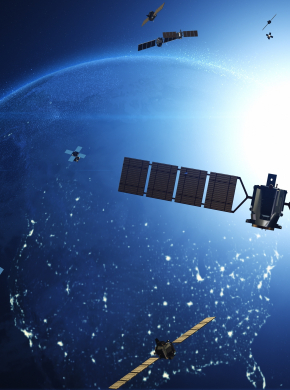The Intelligent System Initiative is a crosscutting initiative that aims to advance the autonomy of space-based systems in a disruptive way. The Initiative adopts a global system-of-system approach, exploiting synergies with application domains from a multitude of sectors. The Intelligent System Initiative works to a rapid timeframe, leveraging the most advanced processing techniques to increase system performance.
In particular, the Initiative targets leapfrog advance systems autonomy, defines the architecture of an end-to-end (E2E) system, including space and ground segments, and demonstrates key technologies for a prototype autonomous satellite. Through a collaborative effort between industry, government and academia, this initiative offers several benefits in the sustainable use of space:
- More autonomous space-based systems will be able to operate for longer periods of time without human intervention, reducing costs and increasing reliability.
- Substantially more autonomous space-based systems will be able to perform complex tasks, paving the way for new missions and applications with time-critical functions.
- Autonomous space-based systems will be able to work together much more effectively, making them more efficient and powerful by making use of complex infrastructures and orchestrations.
Context
Future generations of satellites, and in particular constellations, will drastically increase autonomy to enable more complex operations, operative cost reduction, new services, including for instance resilient cyber-security applications as well as complex constellations and fleet management.
The initiative targets an end-to-end architecture that makes use of one or more satellites and a ground segment. Intelligence and the appropriate level of autonomy shall be distributed among individual space nodes, fleet or constellation and the ground segment. Multiple implementation solutions are possible, with the potential to feature master and slave nodes, thus allowing for autonomy and reliability requirements at system level. For reliability and security purposes, each node will have a local level of autonomy, a channel to feed the node health status to the higher parent group and the system, and a global system autonomy capability. The Intelligent System Initiative is complex and ambitious, with the potential to revolutionise the way we use space. By advancing the autonomy of space-based systems, it will enable new missions and applications that were not possible before.
The programme of work
The roadmap includes a System Study under the ARTES Future Preparation programme, which will run throughout 2024, to identify the general architecture of the initiative key technology development requirements, and a first batch of basic building blocks. For these basic building blocks, ESA will open competition tenders under the ARTES Advanced Technology programme in 2024. More building blocks may stem from the System Study and will enable an In-Orbit Experiment (IOE) mission within the next years. The System Study encourages the use of industrial consultation, to broaden the high-level strategy beyond the specific consortium that will run the System Study itself.
The Intelligent System is a collaborative effort that strives to create an opportunity for industries to work towards a new end-to-end architecture, that encompasses standard interfaces, that covers space and ground, that targets interoperability of different blocks, sufficient level of abstraction for a flexibly reconfigurable system. Besides the Agency-driven development listed below, we welcome further Industry-initiated co-funded activities, which can be submitted via the ARTES Competitiveness & Growth open call for proposal.
The following table will progressively cover the key activities in the Intelligent System Initiative roadmap; the first one is the System Study, and then priority technology blocks will follow, covering the new avionics elements to be started in 2024.
By the beginning of 2025 the IOE procurement will be added, and during 2025, possible new blocks may be added (e.g. in the domain of payload). Entries will be regularly updated as they become ready for publication in the esa-star Publication portal:
| Work Plan Title | Work Plan Reference Number | Further Details |
| Intelligent Platform for Constellations | 1B.140 | Intelligent Platform for Constellations - Thales Study & Intelligent Platform for Constellations - OHB System Study |
| Artificial Intelligence-Based System for Autonomous On-Board Failure Isolation, Recovery, and Resource Optimisation for Telecommunication Constellation | 4A.099 | Artificial Intelligence-Based System for Autonomous On-Board Failure Isolation, Recovery, and Resource Optimisation for Telecommunication Constellation |
| Software Execution Environment for Intelligent Applications | 4G.047 | Software Execution Environment for Intelligent Applications |
| Onboard Data Handling Sub-System for Autonomous Satellites | 4G.044 | Onboard Data Handling Sub-System for Autonomous Satellites |
| Power Module with Advanced Battery Monitoring and Electrical Power System Telemetry Management | 4F.169 | Power Module with Advanced Battery Monitoring and Electrical Power System Telemetry Management |
| Power Module for Autonomous Satellites | 4F.095 | Power Module for Autonomous Satellites |
| In-Orbit Experiment of Autonomous Deployment and Early Operations for Telecom Constellation Satellite | 3E.024 |
(ARTES AT IOE cancelled and will be replaced by a number of Industry proposed ARTES C&G IOEs) |
|
Software Defined Satellite Avionics Development Environment |
4G.046 | Software Defined Satellite Avionics Development Environment |
| Machine Learning Techniques for Data Rate Reduction | 7B.079 | Machine Learning Techniques for Data Rate Reduction |
| Autonomous Health Monitoring for Telecommunication Platform Mechanisms (on request) | 4E.089 | Autonomous Health Monitoring for Telecommunication Platform Mechanisms |
| Intelligent Signal Monitoring Unit for Payload Equipment Autonomy, Health Monitoring, and Reconfiguration | 5C.530 | Intelligent Signal Monitoring Unit for Payload Equipment Autonomy, Health Monitoring, and Reconfiguration |
| Digital Twin of a Spacecraft autonomous and Collaborative Intelligent Multi-Agent System | 4G.050 | Invitation to Tender Link Pending |
| Enhanced AOCS On-Board Autonomy and Adaptability for Satcom Constellations | 4C.075 | Invitation to Tender Link Pending |
| Server in Space Module (SiSM) | 4A.098 | Invitation to Tender Link Pending |
| In-Orbit Experiment for Intelligent Control for Multi-Environment Satcom Satellites (on request) | 3E.033 | Invitation to Tender Link Pending |
FEATURED OPPORTUNITIES
NEWS AND EVENTS
ESA celebrates completion of neXat’s award-winning virtual platform for satellite connectivity
A Belgian company specialising in cloud-based solutions for the telecommunications industry - neXat - has recently presented its newly developed product, neXat Satellite Services Aggregation Platform (neXat SAP) for the management of satellite…
ESA-supported advanced photonics manufacturing project for next-generation satelli…
The European Space Agency (ESA) continues to drive forward-looking satellite technologies through its Advanced Manufacturing Processes for High Reliability Photonics Transceivers (AutoMAIT) project. The successful activity has demonstrated an…
ESA Supports Austrian Innovation in Multi-Orbit Satellite Communications Technology
The European Space Agency (ESA), together with the Austrian Aerospace Agency (ALR/FFG) and the Federal Ministry of Innovation, Mobility and Infrastructure, is supporting the Multibeam Ka-band Satellite User Terminal (MUKAS) project, funded…
ESA-supported Space INSPIRE product line makes next step to launch
The first Space INSPIRE (INstant SPace In-orbit REconfiguration) propulsion system module, recently completed at Thales Alenia Space's Belfast facility, has now arrived in Cannes for integration into the ASTRA 1Q satellite, the first of the Space…
ESA and RBC Signals UK kick off STORM project for dynamic satellite spectrum management
The European Space Agency (ESA) and RBC Signals UK have signed a contract to develop the Spectrum Trade Orchestration and Resource Management (STORM) platform, an innovative solution designed to transform static…
How ESA supported the demonstration of spatially combined amplifiers across Ka and Q Bands
The European Space Agency (ESA) remains a key supporter of advanced satellite technologies, as shown through the "Spatial Power Combining Amplifiers at Ka and Q/V Bands for Telecom Satellites" project. The successful…
How to extend the lifespan of satellites and enabling cost efficiency through AI software
AI investment is booming globally, ESA is helping drive the ongoing transformation, enabled by technological innovations in the satellite telecommunication operations, through strategic research and development…
European Space Agency’s ARTES programme introduces agile process to meet growi…
The European Space Agency’s (ESA) Advanced Research in Telecommunications Systems (ARTES) programme, through the Directorate of Connectivity and Secure Communications, is streamlining its programmatic tools to…
ARTES support leads to MDA Advanced Radiating Antenna (DRA) contract for Telesat Lightspeed
Canadian space technology company MDA has been selected to provide one of the critical technology subsystems on the Telesat Lightspeed satellites. Telesat Lightspeed is the new leading edge low Earth orbit (LEO) satellite broadband network…
GRASP: seizing the benefits of a single antenna design tool
Reflector antennas are by far the most used technology for telecom satellite and ground station antennas. TICRA, a leading provider of cutting-edge reflector antenna modelling software based in Copenhagen, has now under the ARTES programme made…
AlbaPod: the most advanced space-proven PocketQube deployer
The ‘maker’ movement in electronics and the meteoric rise of smartphones have led to a surge in small satellites - such as nano- and picosatellites (picosats are the tiniest of smallsats). But something has to propel these pocket-size payloads…
Novel flat panel antennas give drones long-range satcom capabilities
A satellite communications antenna which fits snugly into the wing of a UAV or ‘Remotely Piloted Aircraft’ (RPA) for use in long-range missions has now ‘got its wings’ – giving the green light for a variety of civilian applications across…














